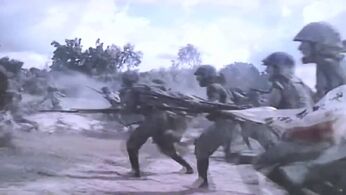
Japanese force conducted Banzai Charge during WW2.
A banzai charge is the term used by the Allied forces to refer to Japanese human wave attacks mounted by infantry units. This term came from the Japanese cry "Tennōheika Banzai" (天皇陛下万歳, "Long live the Emperor"), shortened to banzai, specifically referring to a tactic used by Japanese soldiers during the Pacific War.
The banzai charge is considered to be one method of gyokusai (玉砕, "shattered jewel"; honorable suicide), a suicide attack, or suicide before being captured by the enemy such as seppuku. The origin of the term is a classical Chinese phrase in the 7th-century Book of Northern Qi, which states "丈夫玉碎恥甎全", "A true man would [rather] be the shattered jewel, ashamed to be the intact tile." Among the rules there existed a code of honor that was later used by Japanese military governments.
History[]
Real-Life History[]
The suicide of Saigō Takamori inspired the government that suicide was their final, honorable action.
With the revolutionary change in the Meiji Restoration and frequent wars against China and Russia, the militarist government of Japan adopted the concepts of Bushido to condition the country's population to be ideologically obedient to the emperor. Impressed with how samurai were trained to commit suicide when a great humiliation was about to befall them, the government educated troops that it was a greater humiliation to surrender to the enemy than to die. The suicide of Saigō Takamori, the leader of old samurai during the Meiji Restoration, also inspired the nation to idealize and romanticize death in battle and to consider suicide an honorable final action.
During the Siege of Port Arthur human wave attacks were conducted on Russian artillery and machine guns by the Japanese which ended up becoming suicidal. Since the Japanese suffered massive casualties in the attacks, one description of the aftermath was that "[a] thick, unbroken mass of corpses covered the cold earth like a coverlet".
In the 1930s, the Japanese found this type of attack proved to be effective in China. It became accepted military tactics in the Japanese army where numerically weaker Japanese forces using their superior training in bayonets were able to defeat larger Chinese forces. The Japanese here did not face massed automatic weapons but rather the bolt action rifle of the Chinese, which were slow to cycle the action.
Gate storyline[]
During the war with the Empire, the JSDF and others modern military in the world describes the method of human wave attack by the Empire toward the modern arsenal of the JSDF as similar to banzai charge. However, due to their primitive weapons, the majority of JSDF, Earth military experts and front line soldiers often consider the Empire's charge as nothing more than a blind and idiotic suicide charge since at least in banzai charge, the Japanese soldier at least has gun to fight back their enemy effectively rather than suicide melee since most the time, the majority of the Imperial troops often being turned into target practice.
This tactic proved disastrous for the Empire as evidence during the JSDF Blitzkrieg Offense and the Battle of Marais where thousands of Pro-War soldiers were ordered to rushed into their doom from machine guns, napalm, mortar, air attacks and tank rampages. As a result 90 percent of the Empire's military is destroyed with only bringing insignificant victories.
